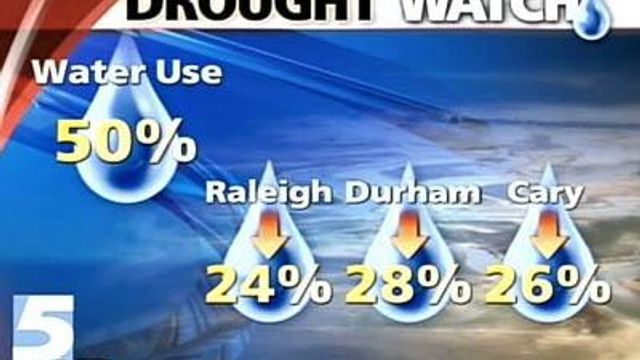Rains Dampen Drought, Not Calls to Conserve Water
Steady rains last week helped ease the severity of the drought across much of North Carolina, but officials continue to stress water conservation.
Posted — UpdatedThe number of counties experiencing exceptional drought conditions – the worst of five categories monitored by the state – dropped from 72 a week ago to 22 this week, the North Carolina Drought Management Advisory Council said in its weekly report Thursday morning.
Exceptional drought conditions are now limited to the western North Carolina mountains, while a swath of the Piedmont region, including most of the Triangle, has improved to the level that officials call extreme drought conditions. Thirty counties, including several along the Virginia border and those immediately east of the Triangle, have been upgraded to the even less drastic condition called severe drought.
Eighteen counties along the Virginia border and in the eastern part of the state are now experiencing moderate drought, according to the report. A week ago, no counties had enough water to be in the moderate category.
Up to 6 inches of rain drenched much of central and eastern North Carolina late last week, the first significant rain the area had seen since mid-September.
But WRAL Meteorologist Mike Maze said no rain is in the forecast for the next week, meaning conditions could begin getting worse again soon.
"We have seen an improvement, but you have to remember that the forecast calls for drier-than-normal conditions through the fall and winter," Maze said. "We could easily slip back into exceptional drought in the coming weeks if we don't see any appreciable rain.
Gov. Mike Easley also noted the long-range forecasts in renewing his call for continued water conservation.
“Even though we are seeing some improvement in the drought map since last week’s rain, every county is still in some form of drought,” Easley said in a statement. “The effect of that rainfall could likely be short-lived, as climatologists are predicting a drier-than-average winter, so we all need to continue to conserve.”
A week ago, the governor called on residents statewide to cut their water consumption in half through Halloween to give people an idea of what sacrifices might be necessary in a water crisis and give officials a handle on what steps work in certain communities.
Most area cities fell far short of that goal, according to a review of data.
Raleigh water customers used an average of 48.4 million gallons a day in October, with large totals early in the month before outdoor sprinkling was outlawed. Since Easley's Oct. 22 request to cut back, average daily demand ranged between 39.1 million gallons and 44.1 million gallons.
In Durham, water usage dropped from 35.6 million gallons to 26.5 million gallons on an average day since
Cary water users have consistently used less than 20 million gallons a day since Easley's request, down from a monthly average of 32 million gallons a day.
"It's really an indication of our citizens," said Mike Bajorek, Cary's interim director of public utilities. "They understand that these are natural resources – there's a finite amount. When the governor started talking, they took heed, and you could tell the drop was substantial."
Cary residents have been under year-round water restrictions since 1996, using alternate-day watering, rain sensors and drought-tolerant plants to cut usage. The town and Holly Springs on Thursday banned all sprinklers for outdoor watering, although they both continue to allow watering plants by hand.
"I think people have gotten the message that water is precious. If we want to continue to have this, we need to use it wisely," Bajorek said.
• Credits
Copyright 2024 by Capitol Broadcasting Company. All rights reserved. This material may not be published, broadcast, rewritten or redistributed.





